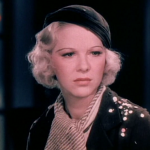 |
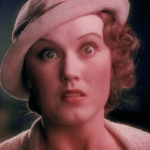 |
 |
| Florence Dempsey … Glenda Farrell |
Charlotte Duncan … Fay Wray |
Ivan Igor … Lionel Atwill |
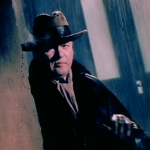 |
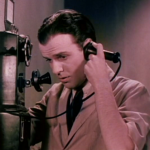 |
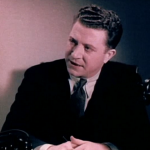 |
| Joe Worth … Edwin Maxwell |
Ralph Burton … Allen Vincent |
Jim … Frank McHugh |
Proof That It’s Pre-Code
- Our plucky reporter lead, Florence Dempsey, gives a wave and cheerful shouts, “You can go to some nice warm place and I don’t mean California!”
- Our heroine turns to a police officer and casually asks, “How’s your sex life?”
- The local playboy has his own private bootlegger.
- There are jokes made about a woman who was accidentally murdered by her abusive husband.
- One of the villains is into ‘narcotics’ and is suffering from what we ‘d call withdrawal.
- The film portrays a bunch of sculptors who, like the character in Song of Songs, like to massage their nude artworks.
- There’s a remark that goes “A cow does that and gives milk besides!” which I’m not entirely sure what it means. However, the censors demanded the line be removed; I’m not sure they know what it means, either, though the implications can let the mind wander into unhealthy territories.
Mystery of the Wax Museum: The Delighted Corpus Delicti
It was around age 11 when I first sat down to watch the 1931 Dracula with my dad. As I watched Dwight Frye stumble about the Gothic castle in near silence, I turned to him and asked, “Did people ever really find this scary?”
“Times change,” he responded. “People are scared by different things now.”
Though I was still a pretty impressionable youngster, I think I understood. And certainly anyone who’s reading this now and has watched horror films go from Evil Dead to Saw to Paranormal Activity and somehow back to Evil Dead in the last 30 years, you can see how our culture has internalized horror and how those movies reflect the world around it– Paranormal Activity is heavily linked with the ‘on all the time’ world of social media while Saw definitely fit right in with the ethos of the Bush administration. And Evil Dead, about possession and being forced to turn on those you trust in love in order to survive, represents a timeless American horror.
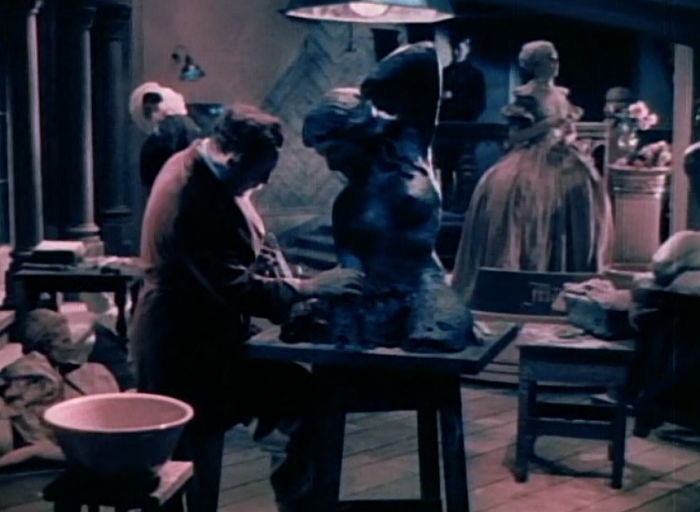
“Don’t worry, folks, I’m sure he’ll get to the pre-Code bits soon. He’s just… waxing philosophically! Ha, I kill myself. By the way, nice sculpture, right? I just love making wax sculptures!”
But going back, way back, to the 1930s, horror films still struggled to uncover the cultural zeitgeist. The Universal, Paramount, and Warners horror films all looked at how science, the supernatural, and the darkest parts of the world intersected. Frankenstein’s monster and the villain at the core of Doctor X (the other famous pre-Code two-strip technicolor horror film) were both man-made, the extension of immoral science that asked ‘how’ rather than ‘why’. But these criticisms, often leveled at elitist scientists, were also indirectly nodding at the 1920s elites who promised a great future and found the nation’s livelihood was a creature beyond their control– horrifying and destructive.
Mystery of the Wax Museum differs from the usual 30s horror film because its central theme isn’t scientific progress but artistic fulfillment. Ivan Igor, renowned sculptor, begins the film about to be honored by the British government for his masterful works of art. By the end of it, he becomes an obsessed monster, too grotesque to fit in his own collection or the rest of humanity at large.
Reconciling emotional needs with realistic liabilities is a big theme in the movie. Igor’s ‘Goofus’, relocating to New York after an arsonist fire by a insurance-happy partner leaves his museum wrecked and his body crippled. He finds himself up against an unlikely ‘Gallant’: snappy girl reporter Florence Dempsey.

Good morning, sunshine!
Florence’s ambition isn’t to be the Michelangelo of wax, though. She’s one of those dames whose heart has been around so much that it’s become calloused. And while she’s a driven amateur detective in her own right, she also can’t be bothered with sentimentality. She wants what she wants: if it ain’t a scoop, then it’s a rich hubby who can get her away from the grind.
Her roommate, Charlotte, disagrees with this pessimistic take on romance. Charlotte is content with living on love if nothing else. It helps that she’s young and beautiful, though that will soon get her into a fair share of trouble.
Her fiance, Ralph, works as one of the sculptors at Igor’s new New York museum. His rates must be extremely paltry considering he’s the only one there not in on a creepy murder racket, and he must be doubly desperate since his boss doesn’t really like the work he produces. Igor tells him, “It’s a cruel irony that those of you without souls should have hands”, which is safe to say not positive feedback. I would imagine poor Ralph had to write off all hopes of a raise at that point.
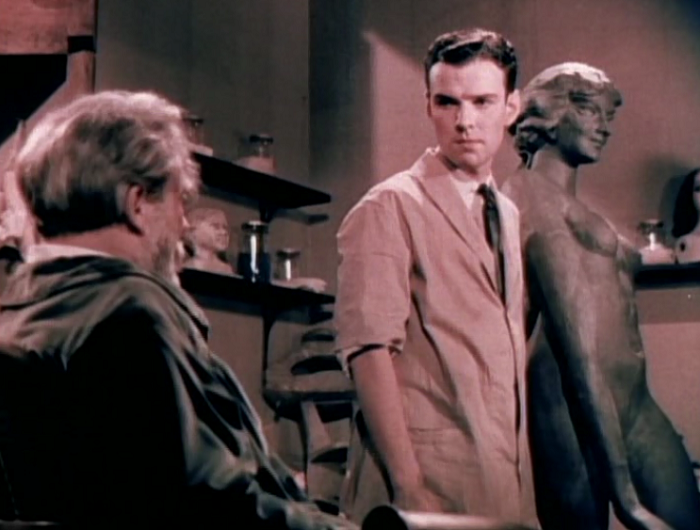
“Ralph, stop sucking.”
Florence, when she’s not bickering with her editor over being drunk and not writing (two constants many journalists must deal with in their careers), has been tipped off to an exciting mystery: a string of mysterious suicides, followed shortly by theft of the resulting corpse. Florence works with the police to try and unravel it, but finds more success scoping out the town’s new wax museum and comparing a few of its centerpieces to the visages of the suicide victims.
Notably, the other humans-come-wax-figures were all pretty revolting people before Igor made them into his creations– a corrupt judge and a narcotics loving socialite became Voltaire and Joan of Arc respectively. However, this pattern is about to change when he catches sight of Charlotte, a woman who looks like his idealization of Marie Antoinette. Charlotte puts him in awe.
Most of the film’s wax statues– save for the ones that catch fire and melt– are portrayed by actors with some makeup and a thousand yard stare. It reaches for that uncanny valley between what we in the audience see as human and what’s obviously not. This could draw you out of the picture a bit, but I like to think it’s a nice bit of underlining by the director, Micahel Curtiz, to remind you of the gruesome mummification the dead have undergone, and how Igor’s twisted dream has made these victims unwillingly immortal.
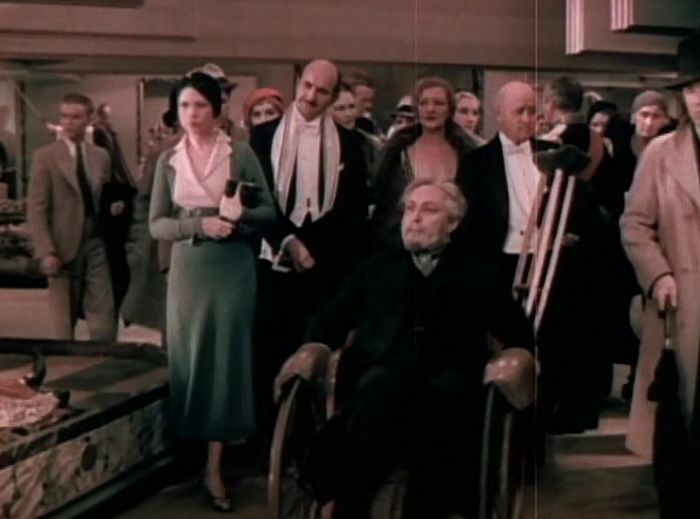
I like how, if you don’t see this scene in motion, you can’t really tell the wax figures from the humans. Same with the picture at the top of this review.
Curtiz’s vision of New York City is barely more flattering than his view of the Gothic castles of Doctor X. While that film leaned towards dark greens of rot and large, overly ornate rooms, Wax Museum shows a world clearly divided by social strata. The clean but busy newspaper office contrasts with the confetti covered streets. Lower, beneath the city’s ground, we see musty basements full of odd angles and looming shadows.
Lower than that we get Igor’s laboratory, a horror of industrialization penetrating into the earth beneath the modernist and bland museum itself. The room he uses to create his sculptures is filled with steel columns and haphazard gangways, with the entire enterprise resembling a metallic spider surrounding a boiling pit of unearthly flesh-colored wax.
Wax Museum errs less towards green and more towards that flesh color, where both the mummified victims and the humans share the same unmistakeable shade of life. The city itself adopts the color on occasion as well, making the whole town radiate with the sense that it is a living, breathing, and horrific monster surrounding them.
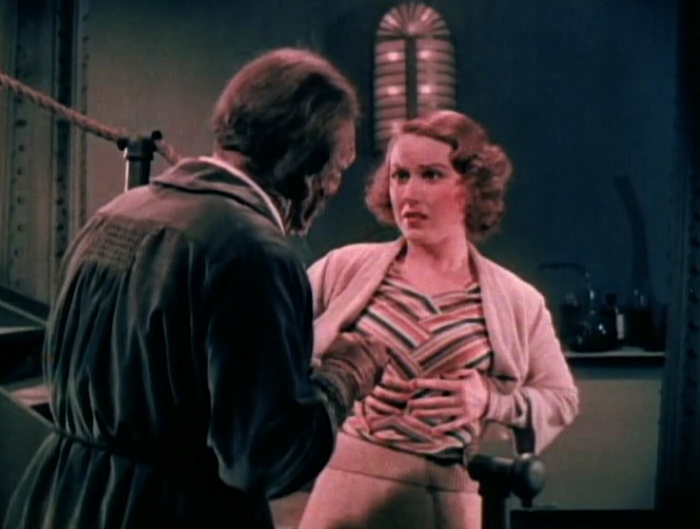
Speaking of rotten flesh, that guy’s face ain’t looking too good.
The film meanders a bit between the edges, languishing in the central mystery which the movie itself solves in its opening minutes. The biggest problem is that, again, the horror was considered so terrifying for the 30s that the movie has been spiced up with liberal amounts of comedy. While I’m not one to turn down a wisecrack from Glenda Farrell any day of the week, it grows tedious as she and the rich playboy she’s wrangled into helping her out fumble through Igor’s silent labyrinth.
Spoilers.
The problem here is that Florence, because of her gender, can’t save the day at the end. Upon seeing Charlotte in the clutches of Igor, who strips her down and prepares to entomb her in wax, Florence turns around and runs away screaming. Charlotte’s salvation comes from Ralph and the New York City police who show uncannily in the nick of time.
Mind you, Florence does learn the film’s lesson: she can’t be that pie in the sky dreamer who takes what she wants over what she needs. She ditches the playboy and agrees to marry her combative editor instead. It’s no His Girl Friday, but serves as another Warner Brothers affirmation to the value of hard work over decadence– almost painfully on the nose.
End spoilers.
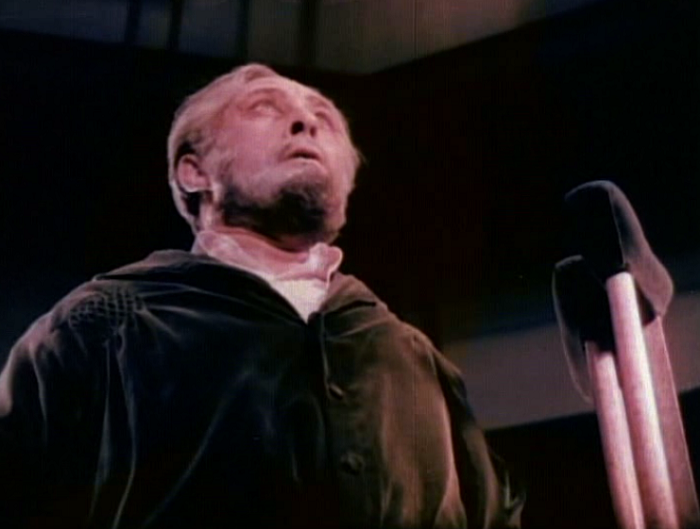
“Something wrong, Florence? You come here prepared to fight a madman, and instead you found a god?”
Besides the strange but fascinating look of the film, Farrell is fun to watch, but better in the similar role of Torchy Blaine (another fast talking reporter) a few years later. Fay Wray gets a few screams and Lionel Atwill gets to chew some scenery again, but both are wasted and I don’t think I’ve ever seen Frank McHugh look so uncomfortable.
Nowadays it’s pretty unlikely that Mystery of the Wax Museum will scare anyone, or even pique the curiosity to anyone unfamiliar with the craftsmanship at work. It’s too bad, but nowadays, like a wax figure, it seems stiffer with age.
Gallery
Here are some extra screenshots I took. Click on any picture to enlarge!
- “Ralph, stop sucking.”
- Here’s that blue color again, this time surrounding Charlotte and luring her to her doom.
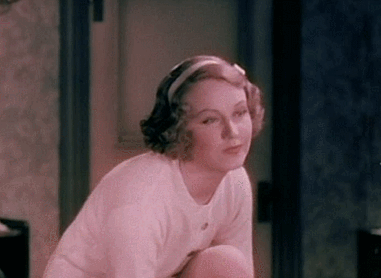

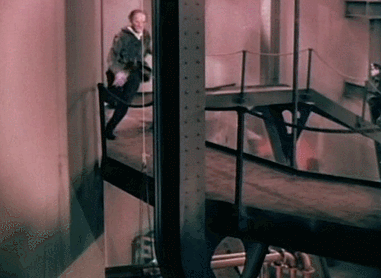
Trivia & Links
- Remade twice as House of Wax with Vincent Price in 1953 and Paris Hilton in 2004. I’m going to go ahead and wager that you can safely skip the 2004 version.
- The cool guys over at Alcohollywood discuss the movie and offer their own custom drinking game and drink for it.
- Nate Yapp at Classic-Horror.Com gives his complimentary take on the film’s atmosphere:
The commendable sets of Anton Grot put these characters in a Gothic, art-deco world that is contemporary New York seen through the eyes of a madman. We are shown a city that looks sinister and awe-inspiring at every glance and a museum full of shadows and intrigue that perfectly complement the horrific elements of the story. The grimly beautiful cityscapes and sets help to pull us into the story and the world where it exists — just as Igor pulls Charlotte into his own demented world as the story unfolds.
- Speaking of, this film’s TCMDB article is mostly about the two-strip Technicolor process and its history.
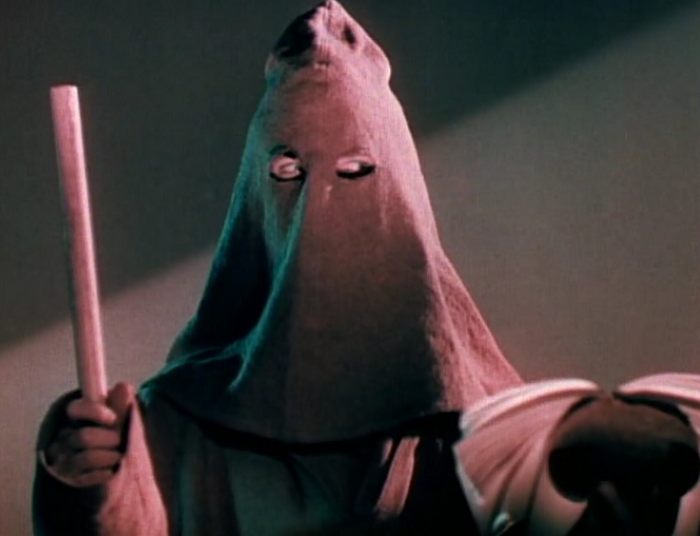
One quick question: who is the character under this mask? Because every other nefarious character is pretty much accounted for during this scene.
- Aaaaaand if you want even more about two-strip Technicolor, here’s a breakdown with examples and, yes, even some nudity from Ben-Hur for you over at the Widescreen Museum.
- This movie is available on blu-ray! … but it wasn’t remastered for blu-ray, and in fact is just a bonus feature on the Vincent Price House of Wax 3D blu-ray. DVDizzy runs it down for you, but it’s kind of a letdown to find that this movie didn’t get any cleanup that it needs at this point.
- In case you want some real nightmares tonight, Greenbriar Picture Show recounts what a nightmare it was to finally get a hold of this movie as it was considered lost for almost 30 years. He also makes great points about how the film’s advertising was almost singularly emphasized for the audience to imagine that the film was filled with sex and nudity– seriously, check out some of those ads he’s got.
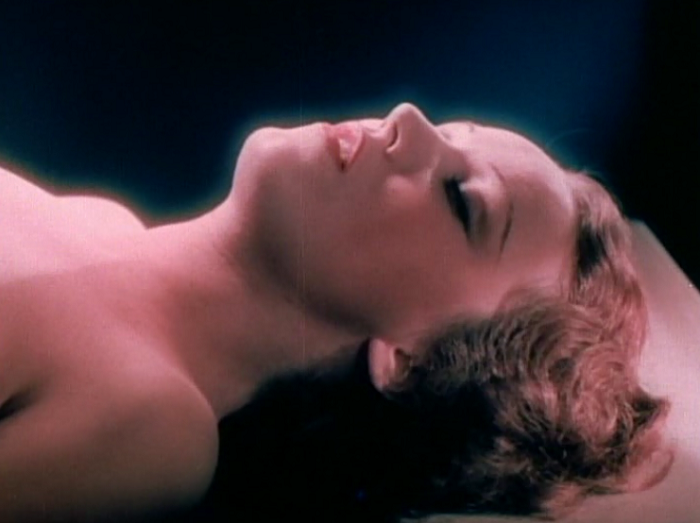
Not naked, but Curtiz’s use of nude wax sculptures is definitely allowing us to connect the dots in our head.
- In another one of those moments when you realize just how much things have changed, Mordaunt Hall’s contemporary review in the Times calls the film “ghastly” and “unhealthy.” Frankly, he’s about two seconds from starting a mob and hunting this film down like it’s a monster named Frankenstein.
- The Nitrate Diva has some excellent film theory for you on this one about how Mystery at the Wax Museum can be seen as a metaphor for film itself. She also talks about the film’s cutting style and Curtiz’s use of implication in his shooting. Great stuff. Here’s a clip:
In Mystery of the Wax Museum, Igor longs to duplicate human beings through what are essentially wax mummies. He doesn’t just want to make wax figures that resemble people—he needs those figures to be existentially bonded to the people they represent, molded around their bodies, like a death mask. And, to paraphrase the great French critic André Bazin, what is film if not another kind of embalmment? The cinema is 24 death masks per second.
Primary Sources
Thanks to Lantern, there are hundreds of issues of fan magazine and industry journals from the pre-Code era available for free. Here are some related articles; click on the ‘View Full Sized Image’ in the bottom right to view!
- Bottom right.
- Cool behind the scenes photo. That’s Farrell and Atwill up top.
- The censorship record I mentioned above.
- Review in the bottom left.
- Longer review.
Awards, Accolades & Availability
- This film appeared in the Wikipedia List of Pre-Code Films.
- This film is available on the same DVD and Blu-ray as its remake, House of Wax. It can also be rented from Classicflix and possibly found on YouTube.
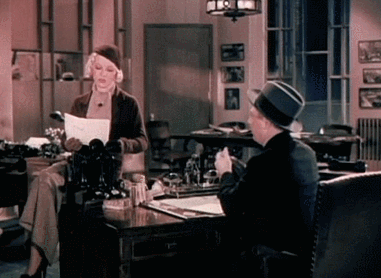 |
Comment below or join our email subscription list on the sidebar!Home | All of Our Reviews | What is Pre-Code? |

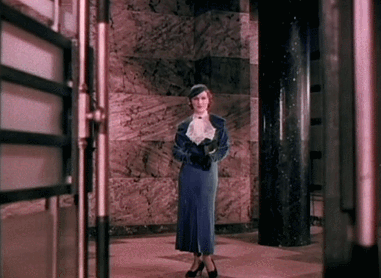

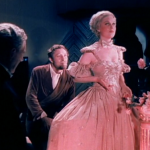

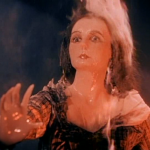


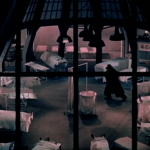

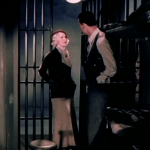

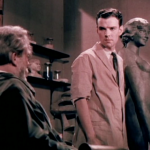
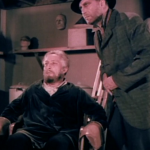
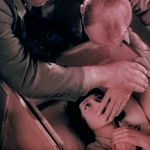
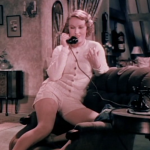
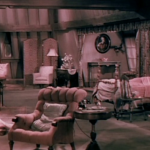
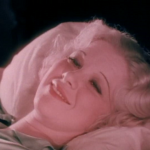

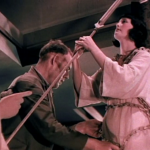
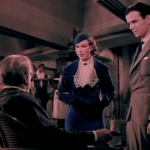
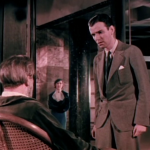
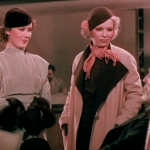

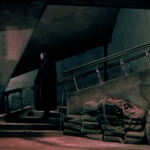
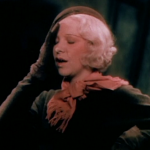
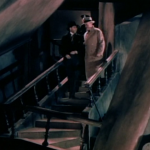
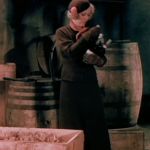
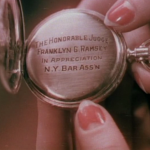
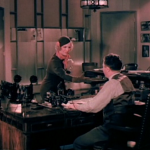




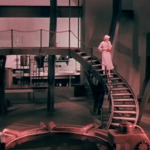

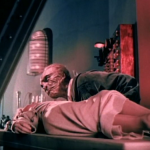
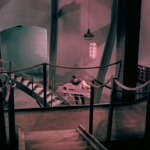
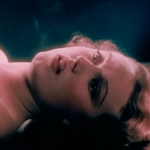
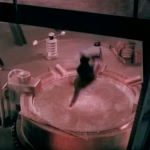
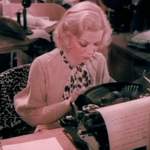
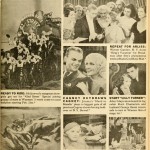
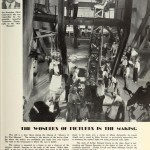
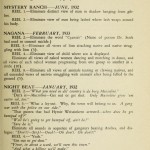
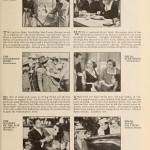
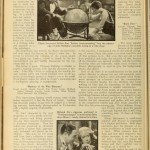


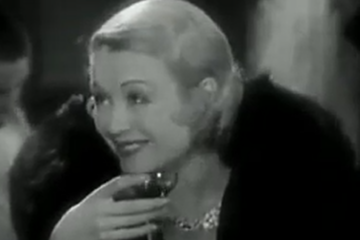
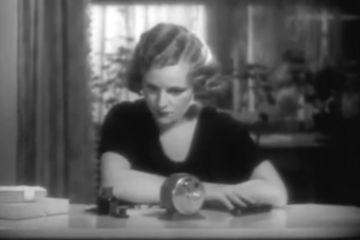
11 Comments
justjack · October 11, 2013 at 4:39 am
Goodness, Fay Wray really was a hottie, wasn’t she. Don’t know why exactly, but that slight overbite of hers is very appealing. Anyhow, fascinating review and great screen caps. I’m surprised, though, that you didn’t have anything to say about the technicolor (though you certainly did point us to sites that do discuss it).
Danny · October 11, 2013 at 10:18 am
Yeah, Wray really had it going on. And I figured I rambled enough about two-strip back in Doctor X on Tuesday that there wasn’t a whole lot left to be said. It’s an interesting process, and definitely worked better for horror movies (one can only imagine Freaks in two-strip– yikes!), but I can see why it was phased out fairly quickly. Like the brief 3D craze we’re going through (and have gone through), I think it works as a gimmick but only rarely gets used to good effect– here and Doctor X being the two exemplars of that for the era.
brianpaige · October 11, 2013 at 4:00 pm
In reality Doctor X and Mystery of the Wax Museum came fairly late in the two color game. Nearly everyone had given up the ghost by 1933 and were gearing up for the debut of real 3 color Technicolor. I can’t name another major 1933 release that was filmed in two color, though Warners messed around with it more in 1932.
There’s just too much stuff going on in MOTWM, which is probably why I prefer Doctor X. It’s probably still easily better than the Price remake though, which is way too neutered by its 50s era. I mean instead of a crack head junkie sculptor we get a drunk, haha. This is one raw, pre code flick. Chicks taking narcotics, strung out junkies, Fay Wray in hot shorts (her intro here…hey now!). Also, in the remake I hated the idea that Price basically sold out everything he believed in for the sake of cheap thrills, whereas here Atwill is resolute in his vision of art.
I’d say this would be a solid like instead of indifferent, but I prefer Doctor X.
Danny · October 11, 2013 at 5:07 pm
Yeah, I think I read in one of the links that the first 3-strip was 34/35, but it was just in a short. 3-strip of course looks great, and I think I mentioned in Doctor X that Warners made these two films in color because of contractual issues. It’s almost too bad– they have such a weird aura and it gives Curtiz a lot to play with and heighten the unreality.
But, yeah, this one gets a little cluttered. Though the pre-Code stuff is great– I almost took a gif of Wray exercising, but that made me feel a little too skeevy. This movie definitely understands, appreciates, and wants you to think about her body.
Andrew · October 12, 2013 at 7:36 pm
^Not that Ms. Farrell is any slouch in that department either, I might add. 🙂
brianpaige · October 13, 2013 at 3:48 pm
You owe it to the readership to include a gif of Fay Wray exercising! It’s not really tawdry or anything. Now if you did the slow motion gif of her falling out of her top in King Kong, that would be another thing.
Danny · October 13, 2013 at 10:31 pm
Ha! We’ll see about that. No, unfortunately Wax Museum is already back in the mail. Maybe I’ll try and get a good one off YouTube later…
casey62 · January 8, 2015 at 8:10 am
MOTW has always been one of my favorite ’30’s horror films. It moves fast and packs in a tight 77 minutes. Fay Wray, as always, is fabulous. She’s sexy without even trying, and NOBODY ever screamed like her. The entire cast is great, as is the pre-code edge.
Danny · January 8, 2015 at 11:01 am
I, too, love Fay Wray. If you haven’t caught this movie’s companion film, Doctor X, I highly recommend it as well– more Atwill and even more Fay.
movielover1994 · July 31, 2015 at 1:34 am
I Like 1933’s Mystery Of The Wax Museum.
Joe · March 28, 2021 at 10:52 am
Just watched this movie on Svengoolie using the restored print from 2019 and looks pretty amazing. The cinematography and art direction take advantage of the two-strip process.
Comments are closed.